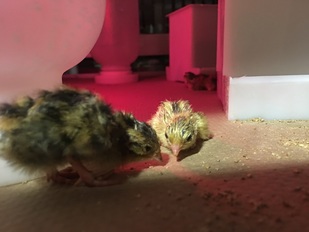|
The birth of 18 little quail chicks was such an exciting time at Second Journey Farmstead. They were all so cute with their fluffy down, their inquisitive nature, and their wobbly legs. They would run to greet us as soon as they noticed us peering in on them, only to turn and flee when we opened the door and tried to touch them; all except for one. One of the chicks was born with the tendency to hold its legs straight. This made standing, let alone walking, impossible. While the other chicks ran around, this chick continued to lie down with its legs fully extended.  Not being able to walk meant that the chick could not get to its food and water, run from danger, or fight back when the other, stronger chicks started to peck at it. So began our family’s discussion about whether this chick could be saved or if it needed to be put down before it received any farther harm. And, with this debate, came the beginning of Anastasia’s heart break. Anastasia fought vehemently that, regardless of how slight the chick’s chances of leading a normal life, every effort should be put forth to save this tiny newborn chick. I am certain that almost every livestock owner has had this debate, at one time or another, with their children and, like us, they have been left with some of the hardest questions to answer: How do you explain to a child who still thinks that everything should be fair that sometimes life is not? How do you convey that sometimes babies are born damaged and that, in the animal kingdom, it really is survival of the fittest? How do we prepare our children for the eventual death of a baby that they have already fallen in love with because it is just so cute and that it needs someone to love it? So, when the chick was found dead the next morning, we did the only thing we could. We tried to comfort Anastasia through the tears.
2 Comments
 Our first batch of hatching quail eggs went into lockdown mode on the afternoon of Good Friday. One of the problems mentioned in SJF Blog post 008 was our difficulty with maintaining proper humidity levels during this critical time period. A soaked sponge was placed directly under the circulation fan to aid in the effort. Despite these difficulties, it generally only took four hours for each hatched chick to clean itself and regain enough strength to be moved to the brooder. In an effort to ensure that nobody was alone in the brooder, we initially waited for at least two chicks to be ready to move before doing so. After that, they were moved once they were ready. We hovered with great anticipation each time one of the chicks started to break through its shell. To be honest, it was extremely difficult to restrain ourselves from helping when we saw one struggle to escape its confinement. The last one to hatch had the most difficulty, so we did end up having to assist it. But, what really got us excited was the fact that the hatch day was on Easter! This was completely unplanned. The date did not register when the eggs were set, only once they went into lockdown mode did we notice the coincidence. How fun it was to praise the resurrection of Christ in the morning and witness the chicks’ birth in the afternoon!  We started our first batch of hatching quail eggs with 21. Three were removed at candling on day six because they were not fertile. Two failed to pip and never made it to the brooder. Three more gave up the ghost in the first week. In all, 16 hatched successfully and were moved to the brooder. Originally, we were ecstatic with an 89% fertile egg hatch rate. Ultimately, 14 of the original 21 eggs made it to week two. That is a 72% fertile egg survival rate. Not too bad for our first hatch, considering all of the difficulties we had to work through with the desktop incubator/hatcher. |
AuthorThis is a family affair. We all get involved in documenting our life in the woods. Archives
April 2017
Categories |

 RSS Feed
RSS Feed